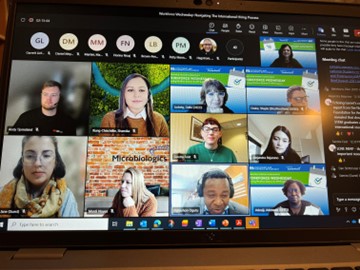November's Workforce Wednesday discussion highlighted the search for talent on a global scale. We heard from a panel of employers and educators on the importance of identifying, attracting, and onboarding talent from around the world. There was a great exchange of ideas – and many resources for Minnesota employers looking to hire New Americans, international students and others were shared.

Sandra Feist – Minnesota House of Representatives (House District 39B), Grell Feist PLC
- I would like to point out that a lot of time we think there is high-skilled immigration and humanitarian immigration, and we really shouldn't have those totally separate in our minds because there are many people coming here from Ukraine, from Venezuela, from all over the world, Sudan, Syria from places that are chaotic and they're coming here for safety, but they are also coming here as pharmacists, engineers, teachers. So, I think that we should remember that people who are coming here for humanitarian reasons have a lot to offer our workforce.
Shamika Kung-Chischille – Sr. Talent Acquisition Partner, Trane Technologies
- One of the challenges of thinking of immigration as one is that there are different types of visas and we do not issue enough H1-B visas to keep up with the demands of technology and our country's infrastructure for those visas. There are a very limited number of visas and very strict qualifications to have post-secondary education in a technical area. If we had more visas, we could bridge the gap.
Alejandra Bejarano – Economic Development Planner, Region 9 (R9) Development Commission
- I know approaching international hiring can be very daunting and intimidating for a lot of employers who have never done it in the past but like any other practice you are bringing on board in your organization you need to learn and educate yourself. There are a lot of resources to help employers navigate this. I would say universities would be a good place to start and chambers of commerce.
Mardi Noyes – VP of Human Resources, Microbiologics
- I totally agree with what everyone said that having that legal support and guidance throughout the entire process from that first conversation with a potential employee is a critical piece to make it work well for us as an employer and for the individual as a prospective employee because we do not have the expertise to do that well on our own.
Jane Sitter, MA – Senior International Career Consultant, University of Minnesota Career Services
- Some employers might think there's a lot of cost and paperwork associated with hiring international students, but in fact there isn't a cost with hiring student interns and the university does most of the paperwork for the employer during the hiring process.
Andy Tjomsland – Talent Acquisition Specialist, 3M
- Employee assistance programs are something we use to help international employees learn about their new community by giving them resources on schools in their area and hiring opportunities for their spouse so they can get acclimated to their new surroundings.
- We also have several employee resource networks where employees with similar identities and backgrounds can share information to new hires as well anyone else who is interested at 3M.
View a recording of this session and other past sessions, plus access a schedule for upcoming Workforce Wednesday sessions on the Workforce Wednesday page on CareerForceMN.com.
For more detailed information, and guidance on where to apply for Foreign Labor Certification, including H1-B, H2-A and H2-B visas, visit the Hiring Foreign Workers page on the DEED website.
DEED's Office of New Americans provides resources and insights on welcoming immigrants and refugees to the workforce.
